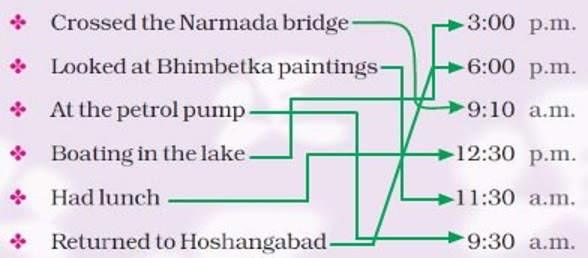NCERT Solutions for Class 4 Maths Chapter-3
This page consists of NCERT Solutions for Chapter 3 A Trip To Bhopal prepared by Maths experts. All the questions asked in A Trip To Bhopal of NCERT textbook are solved with relevant methods recommended by CBSE.
A brief explanation of Chapter 3 A Trip To Bhopal
Chapter 3 A trip to Bhopal is a story-based chapter and very beautiful it explains the numbers and other mathematical calculations which needed to be done while travelling. From a story, kids will understand the application of different mathematics concepts. In this chapter Sugandha a student going on a Bhopal trip while going on this trip, he needs to find out lots of calculations which start from calculating the number of students going on the trip and the number of seats available on the bus to travel. This chapter explains what is the use of numbers by simple calculation (number of children going on the trip). The story moves with the name of stations and different activities which students do during the travel and explained all the important aspects of Maths and its calculation.
Find a free pdf of NCERT Solutions for Chapter 3 A Trip To Bhopal
Q1. Today Sugandha is very excited. All the children of her school are going on a trip to Bhopal with their teachers. Ms. Meenakshi and Mr. Rakesh are talking about the number of buses needed. Ms. Meenakshi — We will need 4 buses. Mr. Rakesh — I think we need at least 5. Ms. Meenakshi — Each bus has 50 seats. Mr. Rakesh — Let us see how many children are going.
|
Class |
Number of children |
|
IIIIIIIVV |
3332425053Total |
• So there are a total of ___________children going.
• If they get 4 buses, how many children will get seats?
• Will there be any children left without seats?
Answer:
33 + 32 + 42 + 50 + 53 = 210
So there are a total of 210 children going.
Number of seats in one bus = 50 Number of seats in 4 buses = 4×50= 200 Thus, 200 children can sit in 4 buses.
4 buses have only 200 seats but the total number of students is 210. The number of students without seats = 210-200 = 10.
Thus, 10 students will be left without seats.
Q2. Each mini bus can take 35 students. How many mini buses are needed?
Answer:
Total number of students: 210
Number of students each minibus can accommodate = 35 Total number of minibus required = 210/35 = 6
Thus, 6 minibusses are required for 210 students.
As the buses start moving, children sing at the top of their voices. Some look outside to enjoy the view of the green fields and the hills.
Indra- When will we reach Bhopal?
Ms. Asha- If we don’t stop anywhere, we should reach there in 2 hours, that is around ________0’ clock.
Answer: It was 9 o'clock when they left. So if they take 2hrs to reach Bhopal then they will reach at 11 o'clock.
If they go to Bhimbetka, they will reach there
- Before 10 o’clock
- Between 10 o’clock and 11 o’clock
- After 11 o’clock
Answer: Before 10 o’clock.
- Have you ever crossed a long bridge? About how many metres long was it? ______
Answer: Yes, I have once crossed 800metres long bridge.
- What is the difference between the water level of the Narmada in the rainy season and now? _______metres.
Answer: Normally the water level of Narmada is 40metres below the bridge but during rainy season the level of the water increases due to rain which is 15metres below the bridge.
The difference between the level of water = 40m - 15 m = 25m Thus, the level of the water rises 25metres during the rainy season.
Q3. Each bus takes about 15 minutes to refill and there are two buses to be refilled. So they stop there for about _______minutes, which means they are late by about ______minutes.
Answer:
If each bus takes 15 minutes to fill and there are two buses to be filled then they have to stop for 2x15minutes = 30 minutes.
Which means they are about 30 minutes late.
Q4.
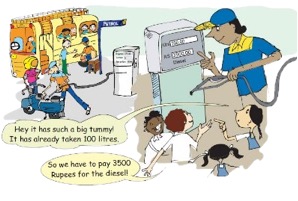
Look in the picture and find the price of 1 litre of diesel.
Answer:
If 100 litres diesel cost Rs 3500.
Then, the cost of 1 litre diesel = Rs 3500/100 = Rs 35 Thus, the cost of 1 litre diesel is Rs 35.
Q5. How much time did Aman take to come out of the toilet?
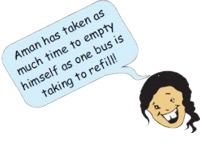
Answer:
If one bus takes 15 minutes to refill then that means Aman took 15 minutes to come out of the toilet.
Q6.
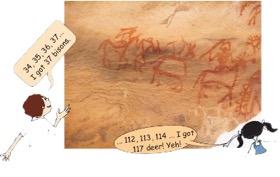
How many more deer are there than bisons?
Answer:
If there are 37 bisons and 117 deers then the number of deers more than bisons
= 117-37
= 80.
Thus, there are 80 more deers than bisons.
Q7. But Bonomala is the happiest because the number of people is even more than the number of deer and bisons together. Her count is less than 200.
- How many people must Bonomala have counted? 214 / 154 / 134 / 177
Answer:
The number of deers and bisons together = 117 + 37 = 154.
If the total number of people is more than the number of deers and bisons together (i.e,154) and still less than 200 then the total number of people must be 177.
Q8. They have spent 1 hour there.
What time is it? ___________They are now moving towards Bhopal. They should reach there in less than 1 hour, at about____________ o’ clock.
Answer:
They were about to reach Bhimbetka at 10 am but they got 30 minutes late. This means they reached Bhimbetka at 10.30 am. If they have spent an hour there and then left for Bhopal then they left at 11.30 am. They should reach Bhopal before 12.30 pm.
Each child is to be given 1 orange, 1 banana and 5 biscuits.

All the children take oranges and biscuits but 38 children do not take bananas. ![]() How many oranges, biscuits and bananas are distributed?
How many oranges, biscuits and bananas are distributed?
Answer:
Total number of students = 210
If each student gets 1 orange, 1 banana and 5 biscuits. Then,
Number of oranges distributed = 1x210 = 210 oranges. Number of biscuits distributed = 5x210 = 1050 biscuits.
Number of bananas needs to be distributed = 210. But, 38 children refused to take bananas. So the number of bananas distributed = 210 - 38 = 172.
Thus, 210 oranges, 1050 biscuits and 172 bananas were distributed among the children.
Q10. I gave four toffees each to four of my friends and three toffees are left with me. How many toffees did I have?
Answer:
Number of friends = 4
Number of toffees for each friend = 4
Total number of toffees distributed = 4x4 = 16 toffees. Number of toffees left = 3
Thus, the total number of toffees = 16+3 = 19 toffees.
Q11. What numbers can you make using 3, 5 and 7? You can make 357 and 537. What others?
Answer:
The other numbers that can be made using 3, 5 and 7 are 573, 375 and 735. Q12. A number becomes double if it is increased by 8. What is the number? Answer:
Let the number be a.
The number gets doubled if it is increased by 8.
So, a + 8 = 2a a=2a-8
Let us randomly place the value of a to satisfy the equation. If, a=1, then 1=2-8 Not satisfying the equation.
If a=5, then 5= 10-8---- Not satisfying the equation.
If a=8, then 8= 16-8------- Equation satisfied.
Thus, the value of the number whose value doubles if increased by 8 is 8.
Q13. Think of a number which can be divided by 2, 3 and 5 and comes between 25 and 50.
Answer:
Numbers that come between 25 and 50 and can be divided by 2 are:
26, 28, 30, 32, 34, 36, 38, 40, 42, 46, 48.
Similarly, the numbers that come between 25 and 50 and can be divided by 3 are: 27, 30, 33, 36, 39, 42, 45, 48
The numbers that come between 25 and 50 and can be divided by 5 are: 30, 35, 40, 45
Therefore, 30 is the only common number which lies between 25 and 50 and can be divided by 2,3 and 5.
Q14. A small ant climbs 3 cm in 1 minute but slips down 2 cm. How much time will it take to climb to 2 cm?
Answer:
It takes a minute for a small ant to climb 3cm and then it slips down 2cm. This means the ant climbs only 1 cm in a minute.
Thus, the ant will take two minutes to climb 2cm.
Q15. There are different kinds of boats. Each has a different ticket price, and also different trip times.
|
Name of the Boat |
Ticket-price |
Trip-time |
|
1. Double-decker |
Rs 30 |
45 minutes |
|
2. Paddle-boat |
Rs 15 |
30 minutes |
|
3. Motor-boat |
Rs 25 |
20 minutes |
|
4. Boat with oars |
Rs 15 |
45 minutes |
- Indra and Bhanu first went in the motor-boat, and then took the oar-boat. How much did they pay for both the boats? Rs How much time did they get for both rides?
- One group of children went for the double-decker trip. They paid Rs 450 in total. How many children went for the double-decker trip?
- Which boat makes two trips in 1 hour?
- Which boat takes less than half an hour to complete a trip?
- Which boat gives them the most time taking the least money?
- Javed went twice for boating. He paid a total of Rs 40. and boated for 50 minutes. Which two boats did he take?
Answer:
According to the chart, the price for the motor-boat per head is Rs 25 and the price for the oar-boat per head is Rs 15. Thus, the total amount Indra and Bhanu paid for both the boats = Rs 50+ Rs 30
= Rs 80.
Time taken for motor-boat = 20 minutes Time taken for oar-boat =45 minutes.
Total time taken = 20+45 minutes = 65 minutes. Thus, for both rides they got 1 hour and 5 mins.
- The price for a double-decker boat per head is Rs 30. If the total amount spent for the group of children is Rs 450 then the total number of students = 450/30 = 15.
Therefore, the group consists of 15 students.
- The duration for Motor-boat is 20 minutes. Therefore, a motor-boat takes less than 30 minutes (half an hour) to complete one trip.
- The boat with oars takes the least money that is Rs 15 and gives the most time that is 45minutes.
If Javed paid Rs 40 and spent 50 minutes then he must have paid for Paddle boat and Motor-boat because:
The price for Paddle-boat and Motor-boat together = Rs15+Rs25 = Rs 40
The duration for Paddle-boat and Motor-boat together= 30 minutes + 20 minutes = 50 minutes.
Q16. Children enjoy different boat rides till 4 o’clock. It is time to return. Now they will not stop anywhere and reach back in two hours. So, they should reach Hoshangabad by ______________o’clock.
Answer:
If they start by 4 o’clock then they should reach Hoshangabad by 6 o’clock. Q17.
1. There are four very old cave-paintings.
Mark the oldest. (a) 4200 years old (b) 1000 years old (c) 8500 years old (d) 1300 years old
2. One bus can carry 48 children. How many children can three buses carry? About — (a) 100 (b) 200
(c) 150
3. Which pair of numbers add to make more than 500? (a) 152 and 241 (b) 321 and 192 (c) 99 and 299
(d) 401 and 91
4. What happened at what time? Draw lines to match.
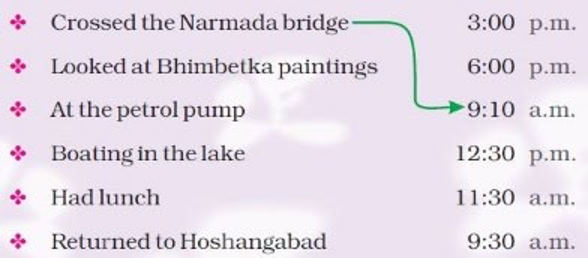
Answer:
(1) There are four very old cave paintings. The oldest painting is 8500 years old.
Hence, the correct option is (c).
(2) Number of children in 1 bus = 48 Number of children in 3 buses = 48
×3 = 144 There are about 150 children. Hence, the correct option is (c).
(3) We will add the pairs to check the pair that has the sum greater than 500.
152+241393 1321+192513 1199+291390 401+91492We can see that 321 and 192 together make
more than 500.
Hence, the correct option is (b).
(4)
